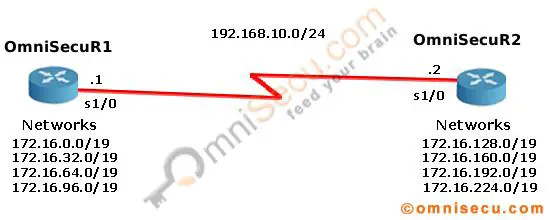Auto Summarization in EIGRP
Auto summarization is a feature which allows Enhanced Interior Gateway Routing Protocol (EIGRP) to summarize its routes to their classful networks automatically.
For example, consider we are planning to use eight subnets of class B default network 172.16.0.0/16, subnetted using a three-bit subnetting as shown below. If we do a three-bit subnetting (Cick the following link if you want to learn more on Class B Subnetting) on default Class B network 172.16.0.0/16, we will get eight subnets as shown below.
• 172.16.0.0/19
• 172.16.32.0/19
• 172.16.64.0/19
• 172.16.96.0/19
• 172.16.128.0/19
• 172.16.160.0/19
• 172.16.192.0/19
• 172.16.224.0/19

Router OmniSecuR1 has four subnets 172.16.0.0/19, 172.16.32.0/19, 172.16.64.0/19, and 172.16.96.0/19 and Router OmniSecuR2 has remaining four networks 172.16.128.0/19, 172.16.160.0/19, 172.16.192.0/19 and 172.16.224.0/19 respectivly.
After configuring Enhanced Interior Gateway Routing Protocol (EIGRP), view the routing table in OmniSecuR1, using the show command "show ip route" command. The output of the show command "show ip route" in OmniSecuR1 is copied below.
OmniSecuR1#show ip route
Codes: C - connected, S - static, R - RIP, M - mobile, B - BGP
D - EIGRP, EX - EIGRP external, O - OSPF, IA - OSPF inter area
N1 - OSPF NSSA external type 1, N2 - OSPF NSSA external type 2
E1 - OSPF external type 1, E2 - OSPF external type 2
i - IS-IS, su - IS-IS summary, L1 - IS-IS level-1, L2 - IS-IS level-2
ia - IS-IS inter area, * - candidate default, U - per-user static route
o - ODR, P - periodic downloaded static route
Gateway of last resort is not set
C 192.168.10.0/24 is directly connected, Serial1/0
172.16.0.0/16 is variably subnetted, 5 subnets, 2 masks
C 172.16.32.0/19 is directly connected, Loopback1
C 172.16.0.0/19 is directly connected, Loopback0
D 172.16.0.0/16 is a summary, 00:00:32, Null0
C 172.16.96.0/19 is directly connected, Loopback3
C 172.16.64.0/19 is directly connected, Loopback2
The output of the show command "show ip route" in OmniSecuR2 is copied below.
OmniSecuR2#sh ip route
Codes: C - connected, S - static, R - RIP, M - mobile, B - BGP
D - EIGRP, EX - EIGRP external, O - OSPF, IA - OSPF inter area
N1 - OSPF NSSA external type 1, N2 - OSPF NSSA external type 2
E1 - OSPF external type 1, E2 - OSPF external type 2
i - IS-IS, su - IS-IS summary, L1 - IS-IS level-1, L2 - IS-IS level-2
ia - IS-IS inter area, * - candidate default, U - per-user static route
o - ODR, P - periodic downloaded static route
Gateway of last resort is not set
C 192.168.10.0/24 is directly connected, Serial1/0
172.16.0.0/16 is variably subnetted, 5 subnets, 2 masks
C 172.16.160.0/19 is directly connected, Loopback1
C 172.16.128.0/19 is directly connected, Loopback0
C 172.16.224.0/19 is directly connected, Loopback3
C 172.16.192.0/19 is directly connected, Loopback2
D 172.16.0.0/16 is a summary, 00:01:27, Null0
Now we can see from the Routing Table of the routers that both the routers are summarizing its subnets to default Class B unsubnetted network 172.16.0.0/16. This will create confusion in network, because both the routers OmniSecuR1 and OmniSecuR2 are advertising the same Class B network 172.16.0.0/16. Each router is advertising each other about the same network.
To turn off Auto summarization feature in Enhanced Interior Gateway Routing Protocol (EIGRP), we can use the "no auto-summary" command from the Router Configuration mode.
Use the following steps in OmniSecuR1 to disable Auto summarization in OmniSecuR1 using "no auto-summary" command.
OmniSecuR1#configure terminal OmniSecuR1(config)#router eigrp 65500 OmniSecuR1(config-router)#no auto-summary OmniSecuR1(config-router)#exit OmniSecuR1(config)#exit OmniSecuR1#
Use the following steps in OmniSecuR2 to disable Auto summarization in OmniSecuR2 using "no auto-summary" command.
OmniSecuR2#configure terminal OmniSecuR2(config)#router eigrp 65500 OmniSecuR2(config-router)#no auto-summary OmniSecuR2(config-router)#exit OmniSecuR2(config)#exit OmniSecuR2#
After disabling Auto Summarization using "no auto-summary" command, again check the routing tables in OmniSecuR1 and OmniSecuR2 to confirn the routes are advertised individually as separate subnets, using the show command "show ip route" command as shown below.
OmniSecuR1#show ip route
Codes: C - connected, S - static, R - RIP, M - mobile, B - BGP
D - EIGRP, EX - EIGRP external, O - OSPF, IA - OSPF inter area
N1 - OSPF NSSA external type 1, N2 - OSPF NSSA external type 2
E1 - OSPF external type 1, E2 - OSPF external type 2
i - IS-IS, su - IS-IS summary, L1 - IS-IS level-1, L2 - IS-IS level-2
ia - IS-IS inter area, * - candidate default, U - per-user static route
o - ODR, P - periodic downloaded static route
Gateway of last resort is not set
C 192.168.10.0/24 is directly connected, Serial1/0
172.16.0.0/19 is subnetted, 8 subnets
D 172.16.160.0 [90/2297856] via 192.168.10.2, 00:03:09, Serial1/0
D 172.16.128.0 [90/2297856] via 192.168.10.2, 00:03:09, Serial1/0
D 172.16.224.0 [90/2297856] via 192.168.10.2, 00:03:09, Serial1/0
D 172.16.192.0 [90/2297856] via 192.168.10.2, 00:03:09, Serial1/0
C 172.16.32.0 is directly connected, Loopback1
C 172.16.0.0 is directly connected, Loopback0
C 172.16.96.0 is directly connected, Loopback3
C 172.16.64.0 is directly connected, Loopback2
OmniSecuR2#show ip route
Codes: C - connected, S - static, R - RIP, M - mobile, B - BGP
D - EIGRP, EX - EIGRP external, O - OSPF, IA - OSPF inter area
N1 - OSPF NSSA external type 1, N2 - OSPF NSSA external type 2
E1 - OSPF external type 1, E2 - OSPF external type 2
i - IS-IS, su - IS-IS summary, L1 - IS-IS level-1, L2 - IS-IS level-2
ia - IS-IS inter area, * - candidate default, U - per-user static route
o - ODR, P - periodic downloaded static route
Gateway of last resort is not set
C 192.168.10.0/24 is directly connected, Serial1/0
172.16.0.0/19 is subnetted, 8 subnets
C 172.16.160.0 is directly connected, Loopback1
C 172.16.128.0 is directly connected, Loopback0
C 172.16.224.0 is directly connected, Loopback3
C 172.16.192.0 is directly connected, Loopback2
D 172.16.32.0 [90/2297856] via 192.168.10.1, 00:00:05, Serial1/0
D 172.16.0.0 [90/2297856] via 192.168.10.1, 00:19:14, Serial1/0
D 172.16.96.0 [90/2297856] via 192.168.10.1, 00:19:14, Serial1/0
D 172.16.64.0 [90/2297856] via 192.168.10.1, 00:00:05, Serial1/0